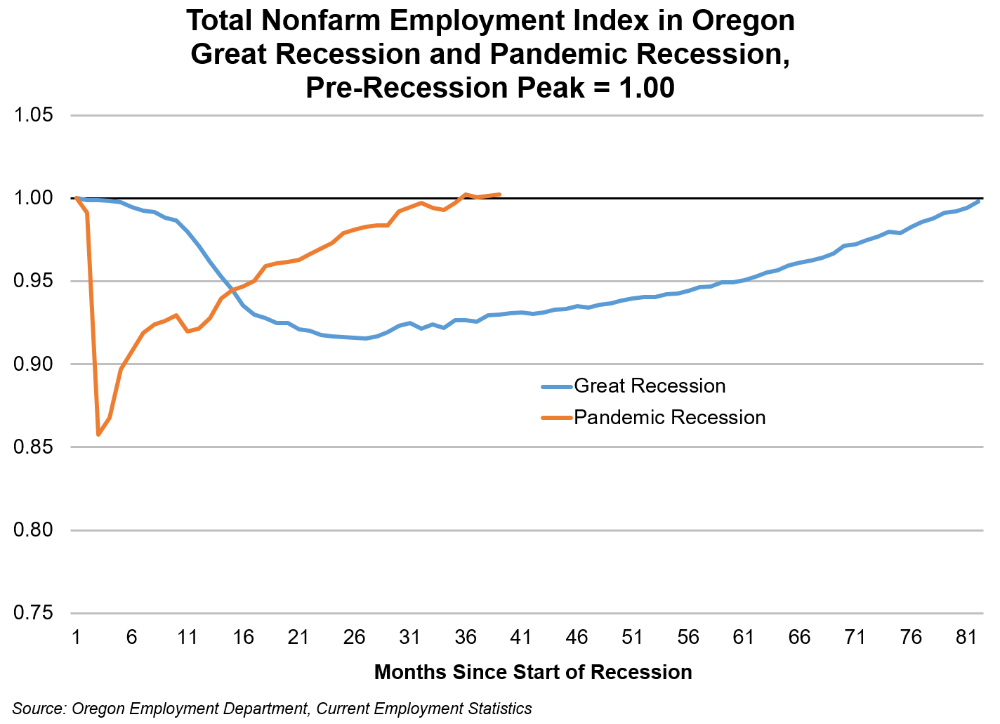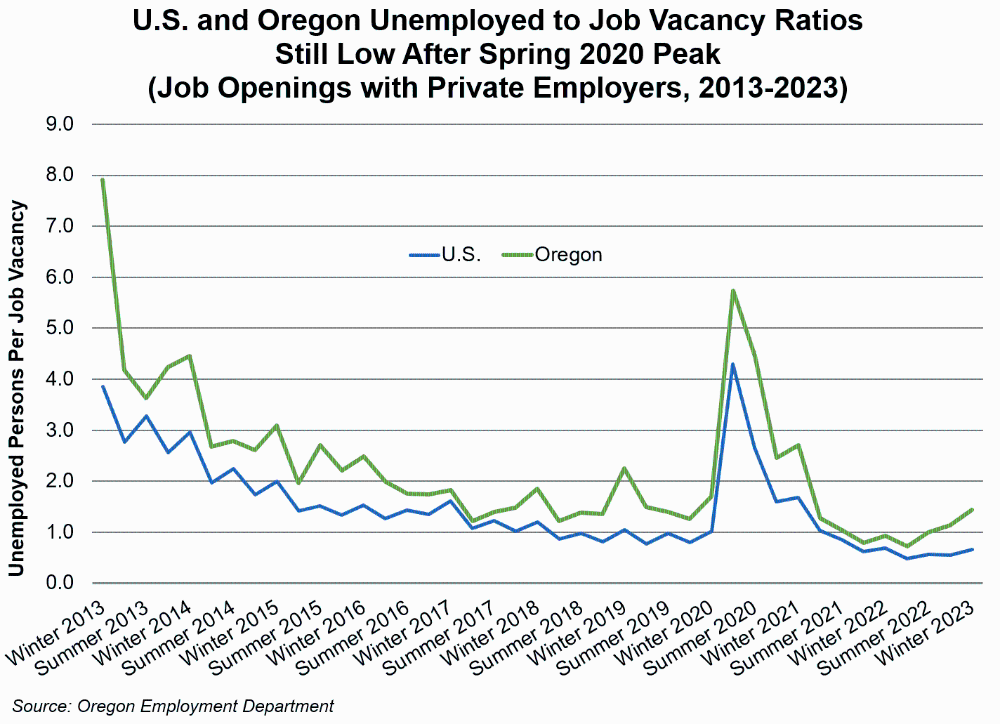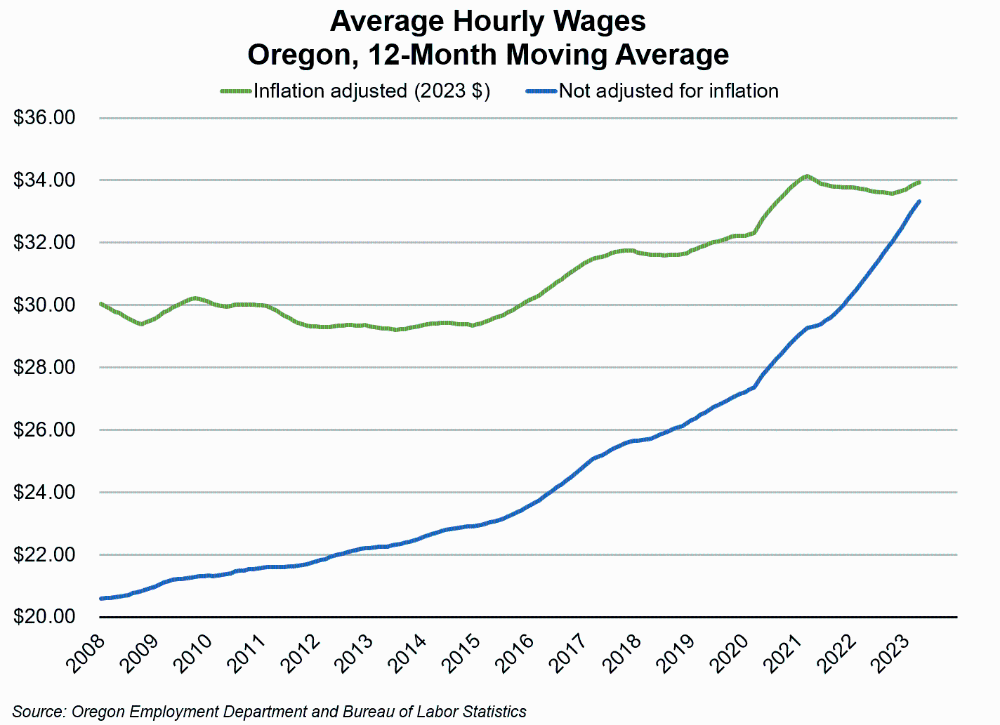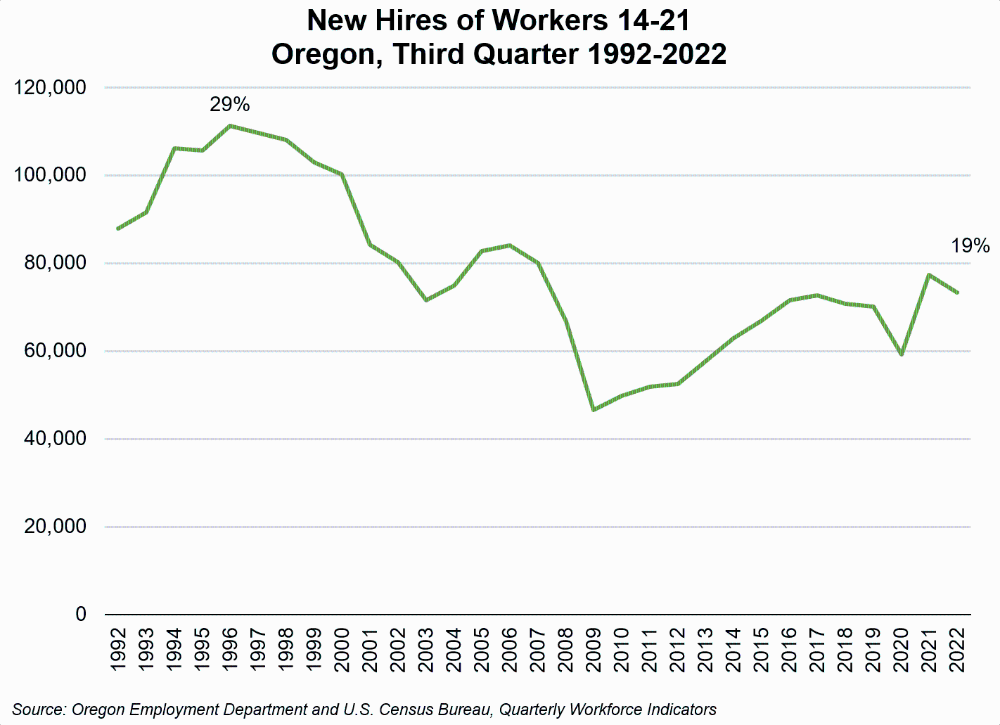Recruitment and Retention in a Tight Labor Market
June 9, 2023Three years on, the Oregon economy has fully recouped the massive job losses experienced in spring of 2020. While that’s fantastic news, continued job growth hasn’t been easy, largely because a tight labor market (that is, few workers available relative to hiring demand) makes jobs very difficult to fill.

In comparison with the Great Recession, which began in late 2007, the jobs recovery from 2020 has been robust and rapid. In some ways, that quick recovery leads to growing pains and difficulties for employers.
That is largely because rapid expansion and rehiring since mid-2020 created an environment of intense competition for workers. The number of open job vacancies has consistently been much higher than before the recession, while unemployment remains near record lows. Visualizing this by looking at the number of unemployed people per job vacancy is instructive.

As of early 2023, there were roughly 1.4 unemployed people for each job opening at a private company. That’s up slightly as the number of job openings has dipped and unemployment ticked up early in the year. At various points in the last two years, that ratio has been less than one, meaning there have been more job openings than people that are actively looking for work. In fact, that’s still the case in the U.S. overall.
There’s no doubt that we still find ourselves in an extremely tight labor market, where availability of workers is low and employer competition for workers is high. This article will offer three tips on how to use data and labor market information to position your business for success.
Tip 1: Ensure Your Wages and Benefits are Competitive
Upward pressure on wages is something we’ve all become deeply familiar with in the last several years. Staying on top of the quickly changing environment is more critical than ever to recruitment and retention.

Across the economy, wage growth has taken off several times in the last 10 years. The blue line represents the average wage as the number that shows up on paychecks, while the green line considers the “real value” of that wage, by adjusting for inflation. On paper, workers have gained quite a bit since 2008. Accounting for rising cost of living, there have been real gains as well, although in fits and starts which tend to align with tight labor markets.
Fast wage gains in 2021 and 2022 were offset by equal or higher gains in inflation, which kept the green line level. Wage growth has picked up again in recent months, as inflation slows.
QualityInfo.org has an Occupational Profiles Report tool allows you to search nearly 800 occupations for up-to-date Occupational Employment and Wage Survey (OEWS) wage data to see entry-level, mid-range, and higher pay scales for jobs in 800 different occupations, and how those vary across regions of the state. The Employment Department’s Workforce Analysts can provide a clearer picture of local conditions.
One final note on wages – in this tight market, competitive wages are necessary but not sufficient to recruit and retain workers. Being informed about benefits will also pay dividends. Our most recent survey on employer-provided benefits comes from 2018, so doesn’t account for post-COVID labor market disruption or new programs such as Paid Leave Oregon, but still provides important context on what industries are likely to provide which benefits. There is also recent national data available from the Bureau of Labor Statistics’ Employee Benefits Survey on employer provision of benefits such as life and health insurance, retirement or paid leave by industry and occupation.
Some employers can’t raise wages quickly for various reasons, including limited non-profit funding and union contracts. Improved benefits, perks, added flexibility, and other non-monetary improvements to working conditions can also help employers stand out to a limited candidate pool.
Tip 2: Find the Slack in the Labor Market
For business owners working to fill job vacancies, there’s a relatively small pool of potential hires currently. Many small changes such as earlier than expected retirement waves and a surge in new business startups add up to mean that the labor pool isn’t exactly the same as it was before. However, consistently low unemployment and a full, if geographically uneven, economic recovery indicate that there isn’t a hidden pool of workers that are holding back from re-entering the labor market.
Yet there still may be areas of “slack” in the labor market. One example is younger workers. While the unemployment rate for young people is consistently higher than for workers above the age of 25, youth unemployment rates have recently been very low nationally. Still, it’s a different job market for young workers than in past generations. As recently as the year 2000 there were about a third more workers age 14 to 21 hired during the summer – about 29% of workers hired during the third quarter of the year, compared with 19% in 2022.

This means that it’s likely some young people who would want a job at your business might not consider it as an option. And if you do get that young person hired, they might require more training than a teenager might have needed in the 1990s, simply because they’ve had less job opportunities than previous generations.
Relaxing experience requirements is a good strategy, where possible, to increase the candidate pool. In 2022, our Job Vacancy Survey found that difficult-to-fill vacancies were far more likely to require previous experience. Employers appear to be decreasing emphasis on experience relative to prior years. If it’s not essential to job duties, experience requirements only keep people from applying, by far the number one reason that jobs were considered difficult to fill last year. Employers may need to ramp up the intensity of recruitment and seek workers in ways they haven’t in the past in order to expand the available pool of candidates who know about their job listings.
Tip 3: Retention is the Best Medicine
At the end of the day, the best recruitment strategy is a happy workforce. An ounce of retention is worth a pound of recruitment, because every retained worker is another position you don’t have to fill in the first place. In an environment where nearly 3% of workers voluntarily quit their jobs each month, increased turnover can add up very quickly.
What keeps employees satisfied is a somewhat difficult question to answer, although starting with wages and benefits is a good first step. The Conference Board’s 2023 survey of employee satisfaction found that more workers are satisfied with their jobs than at any point in the survey’s history, although workers who had recently changed jobs and those with remote or hybrid work environments were significantly more satisfied. Businesses face limitations of what type of environment they can provide to employees, but meeting employees where they are to the extent possible seems to be a key part of a successful retention strategy.
Bonus Tip: Covering Your Bases
In tight labor markets, employers tend to layer help wanted signs with other efforts such as referral incentives, signing bonuses, advertising jobs several places online, and working with recruiters outside of their geographic area. In an era of intense competition, diversifying your recruitment portfolio is the name of the game.
A key benefit for employers to take advantage of is WorkSource Oregon. Businesses can list jobs in WorkSource’s job matching system, where tens of thousands of workers register to find new employment or a career upgrade. Business services staff can often help with targeted recruitment or screening job candidates. All services are provided free for Oregon employers.
Besides listing jobs, WorkSource can also help you access key training and workforce development programs such as On the Job Training (OJT). OJT provides wage reimbursements for employers who want to upgrade a new hire’s skills. If you’ve decided to hire that teenage worker who shows promise but doesn’t have all the required experience, OJT can lessen the risk of investing to develop them into a key part of your workforce.
Employers are facing the challenge of staying up to date in a dynamic economy with lots of job openings and a scarcity of applicants, while also trying to get business done. It can feel overwhelming to track data and trends when the economic situation is rapidly changing, but being open to change and new ways of recruiting and retaining your workforce may be the edge your business needs. Even though it’s a tough time to recruit and retain workers, taking advantage of all the resources available is the best way to position your business for success.